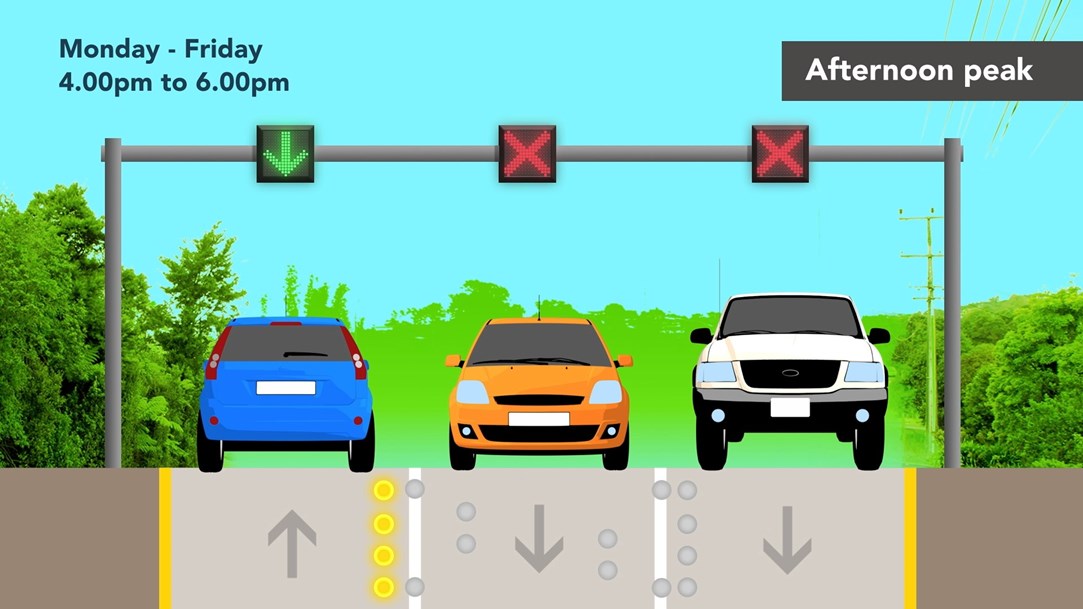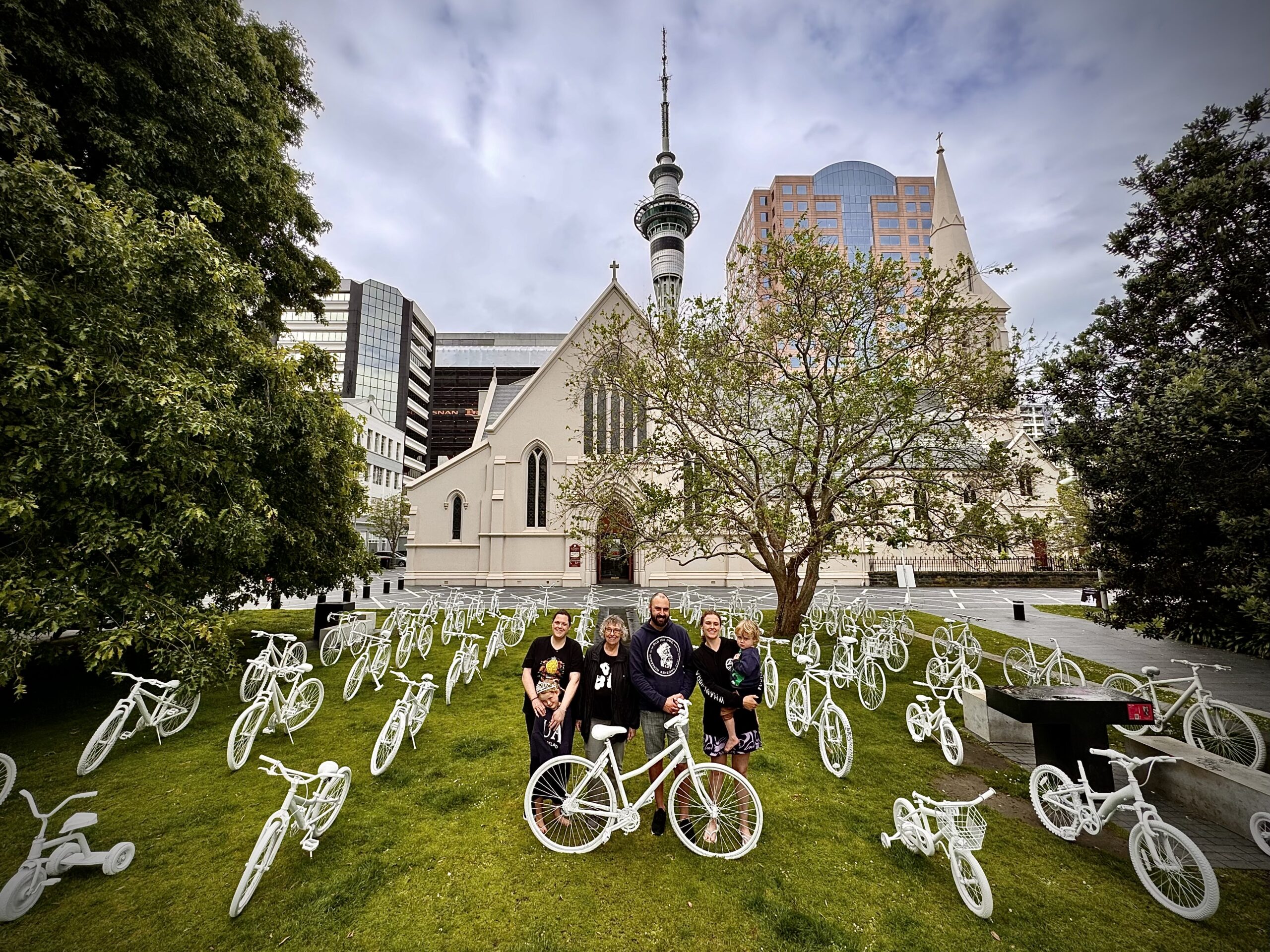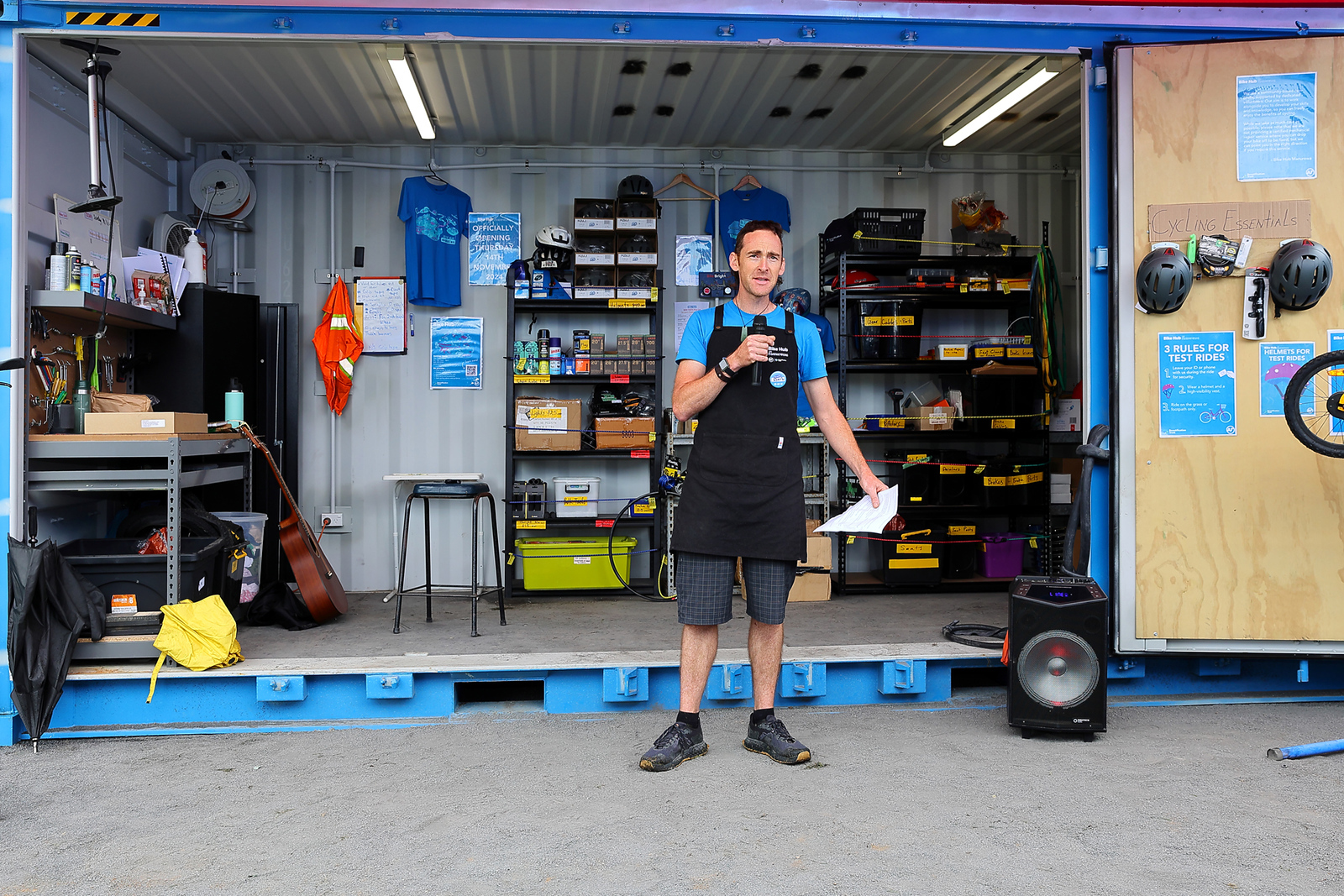AT is patting itself on the back for being smart with technology: they’re planning to squeeze an extra lane into a road currently painted for two opposing lanes with long flush medians, by using on-ground lights and overhead gantries to allow cars to drive along the flush median at peak times.
Like the ‘zipper’ device on the Harbour Bridge, this reversible middle lane is a technique for accommodating tidal flows of morning and evening traffic.
The lucky location for the first trial of this dynamic lane technology, which will run for a year and a half, is the landward end of Whangaparaoa Rd, which runs along the spine of the peninsula and services dormitory waterfront suburbs between Stanmore Bay and Gulf Harbour.
David Squirrell, a local who drives and bikes along the road, has written a guest post for us outlining the trial’s shortcomings. We back David’s concerns, and ask: what are the implications of this trial for efficient travel – including bikes, walking, high-occupancy vehicles, and buses, across Auckland?
And is this truly a future-focused approach – or the last gasp of some very old-fashioned thinking?

What’s the problem?
At first glance it seems smart: using lights on the road to allow for two lanes of peak hour flow. And ‘dynamic’ always sounds like a good thing. The approach aims to ‘optimise efficiency while also ensuring a safe environment.’ Who doesn’t like things to keep moving?
But once you delve into the scheme, its fatal error becomes clear. This is dated transport planning based on moving cars rather than people, with concomitant negative effects on walking, cycling, and public transport. If this trial is the precursor for a similar approach across Auckland, we’re deeply worried.
History
Bike Auckland has a long history of concern about AT’s efforts on Whangaparaoa Rd. Some years ago, AT tried to double-lane the section of the road nearest to Hibiscus Highway, but found it couldn’t justify the funding on NZTA’s benefit/cost criteria. Bike Auckland was consulted in the hope we would support the project, thereby improving its funding rate. We opposed the project because it was car focused, did not prioritise public transport and elevated the risk for cyclists using the road.The $20m project didn’t proceed.
We were not consulted on the upcoming trial of dynamic lanes. Had we had been asked to comment, we would have given the project a big fail again.
Safety Concerns for Walking and Cycling
We asked AT to share the Opus safety audit with us, as we were concerned again at the lack of attention to people walking and cycling on the Peninsula. These are our major concerns, with quotes from the safety audit in italics:
- This is very much a uni-modal solution, focusing on cars
- There’s no proactive design for active modes, nor any acknowledgement that they’re part of the solution. AT notes that while the trial ‘does not solve the cycling and pedestrian deficiencies for this section’, if the trial is successful, it may ‘initiate considering additional improvements for this section of Whangaparaoa Road in terms of both walking and cycling.’
- Even public transport gets a raw deal out of this, with no prioritisation for buses
- While there may well be ‘a low number of both pedestrians and cyclists using the corridor’ we disagree with the contention that ‘latent demand at this stage is likely to remain low given the location’. What evidence does AT have for that statement? On one side, we have Silverdale PT and shops, and on the other a large residential catchment. We’re willing to bet this corridor would be very popular with cyclists if there were safe facilities linking the two – which is why it’s designated a Cycle Connector on the Auckland Cycle Network.
- AT’s disdain for pedestrians is shown by this statement from the safety audit: ‘While there is not a footpath for the entire section, there is berm which pedestrians can use, or if for the purposes of catching a bus then make use of a closer bus stop AT recognises that this is an inconvenience to pedestrians who are centrally located on this stretch of road. While the installation of new pedestrian facilities is not a part of this trial, AT will monitor and consider improved pedestrian facilities as a separate project, should the trial prove successful. Really? So it’s ok to inconvenience people walking to and from buses, and to expect them to used muddy grass berms to connect to their closest bus? How does this work for ‘wheeled pedestrians’ using wheelchairs or mobility scooters, or pushing strollers? (In the video, you can actually see pedestrians and at least one cyclist trundling along the grass from about 2 minute mark).
- For those on bikes who choose to bike along Whangaparaoa Rd (or are thinking of giving it a try, to get to the bus station), this quote from the safety audit has us reeling:
‘Reduced lane widths and removal of the flush median during peak periods will constrain the available space for motorists to pass cyclists, however providing two lanes of flow in the predominant direction will enable vehicles to change lanes in order to pass cyclists. The reduction in speed limit at the beginning of the trial should contribute to mitigating safety concerns for cyclists.’
In other words, AT’s expectation is that people on bikes will ride in a road lane with significant interaction with motorists – but it’s fine, because motorists will observe the lower speed limit (reduced for the duration of the trial to 50kmh – 30kmh having been judged too difficult to enforce).
In plain terms, we believe AT is actively promoting an unsafe environment for cyclists. We say: reduced speed limits are not an effective mitigation here. The only safety measure we would accept is separated cycle lanes.

Would you ride alongside these vehicles at 50kmh? Note: the safety audit points out that installing multiple metal gantries along a 60kmh (or 50kmh) stretch of road in itself adds new travel hazards to travel. The suggested solution is to add further protection to the gantries – while also ensuring that the protection doesn’t become a new hazard in itself. (Image: Auckland Transport) After we asked about walking and cycling safety, AT agreed in correspondence with us that adding cars to the median strip makes crossing the road more difficult at peak times – but noted that fewer than 15 people currently cross this section of road per day.
AT’s position is that traffic flow should ‘result in better platooning in traffic and therefore create gaps for pedestrians to cross the active 3 lanes.’ Pedestrians will nonetheless be encouraged to cross at either end of the trial section, at the Hibiscus Coast Highway or Red Beach Road. Here’s how far that is:
 And here’s what that looks like at each end.
And here’s what that looks like at each end.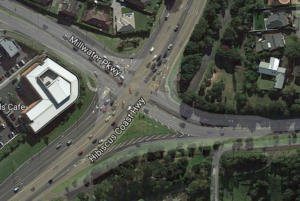

The bigger picture
On the larger scale, AT’s solution of ‘address[ing] peak congestion on Whangaparaoa Road’ with a tidal flow device is doomed to failure. All it will do is encourage more car traffic, and create bottlenecks at other parts of the network.
Whangaparaoa residents are already battling for choices, as evidenced by the increasing demand on park-and-ride facilities at the bus stations. These become jammed earlier and earlier in the day, as seen at the Silverdale bus park any morning of the week.
In our email discussion with the project team they accept that more could be done to improve PT and active modes, but say that this would happen further down the track:
“In terms of measures to promote more efficient PT to bus and ferries as part of this trial, this is and is particularly being considered given the timely roll-out of the new FSN network during the implementation of the dynamic lane project, however given the primary intent of the trial is to first confirm proof of concept of dynamic lanes, and simultaneously address peak congestion on Whangaparaoa Road, before progressing towards a more complete solution.
The LB have also requested the possibility of there being an express bus service along this route, which we are considering introducing together with the trial if possible, noting that the bus service already closely resembles an express service through this area with no stops along Hibiscus Coast Highway. Introduction of a T2/T3 lane is certainly something AT would like to consider in the short-term future should the trial prove successful. An important element associated with the use of dynamic lanes, is the possibility of the tool to provide additional road space for other modes – higher-occupant vehicles, buses and cycling.”
It’s a shame AT didn’t listen more to the Local Board, as this must be an expensive project (we’ll share the costs with you once we hear from AT). Imagine the outrage from local drivers if AT tries to close off access to one of the lanes down the track to cater for HOV?
What is the value of the trial to Auckland as a whole if all it does is encourage more cars onto the road, a result that is contrary to AT’s and the NZTA’s goals for other arterial roads carrying heavy peak hour volumes in Auckland? Just as recently discussed for Devonport’s Lake Rd, the solution for a more efficient corridor is to get more people out of their cars and onto buses and bikes.
Moreover, managing a tidal flow is very expensive both from a capex and opex perspective. And in this case, we consider it a waste of ratepayer money. Not only does this trial project involve lights in the road surface, it also includes 6-8 overhead gantries, and road resurfacing to make sure there are no ‘ghost markings’ that may confuse motorists.
Bike Auckland could support this trial if there were separated cycle lanes in the mix, plus PT/HOV prioritisation. But it’s inconceivable to us that a project with this level of investment won’t even include bus/T3 prioritisation. It’s just bad transportation design all round, and not befitting a 21st C city.
If AT is running trials that are purely about moving more cars – and thereby moving any discussion of multi-modal corridor efficiency another year and a half into the future – then we say it’s not dynamic at all: it’s a dinosaur.
(Thanks to Bike Auckland’s infra leader for the Shore, Steve Southall for context for this blog post)
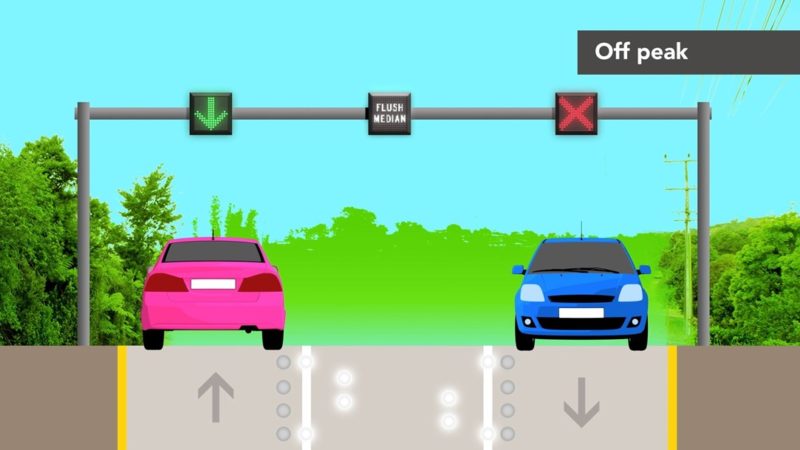
Whangaparaoa Rd soon; an arterial road in your neighbourhood next? Note: the safety audit points out that many drivers may not be familiar with the phrase ‘flush median’, but that’s the wording the gantries will use for the middle lane when it’s not in use – rather than, say, a red cross or the words ‘lane not in use’. Let’s see how that goes. (Image: Auckland Transport)

